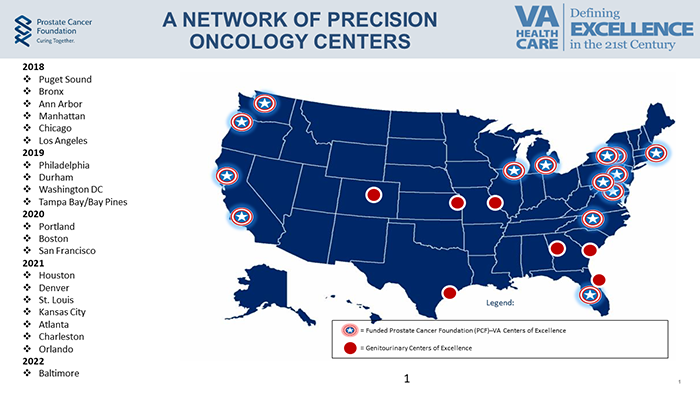Veterans’ Study Demonstrated High Survival Rates
ANN ARBOR, MI — Accurate information regarding treatment outcomes after radiation therapy for localized prostate cancer is important for shared decision-making. Yet, much of the prognostic data upon which physicians base their discussions with patients is likely outdated and doesn’t reflect contemporary real-world outcomes, a new study has shown.
“The historical way that we counsel patients on prognosis tends to derive from the results of large meta analyses of clinical trials for prostate cancer,” said Daniel Herr, MD, PhD, a radiation oncologist in Ann Arbor, MI. Such clinical trials are complicated by the fact that prostate has a long natural history, he said. “It takes many years to develop metastasis and often many years for a patient to pass away from prostate cancer. For a clinical trial to give you relative prognostic information for over survival, for example, you need to have about 20 years of follow-up for prostate cancer specifically.”
Because of the need for long follow-times, by the time doctors have aggregate information on prognosis, the trials on which the information is based is outdated, he explained. “The way we treat patients today is very different from the way we treated them in the 1990s, early 2000s.”
To determine outcomes that provide more current and timely prognostic data, Herr and his colleagues at the VA Ann Arbor Healthcare System and elsewhere conducted a large population‐based study of contemporary outcomes in a national cohort of patients with localized prostate cancer undergoing definitive radiation therapy with or without concurrent androgen deprivation therapy within the VHA from 2005 to 2015. National Death Index data were used through 2019 for overall and prostate cancer–specific survival and identified date of incident metastatic prostate cancer using a validated natural language processing algorithm. 1
“We took that data and curated it using that natural language processing algorithm to determine the date of incidence of metastatic disease for all of these patients,” he said. “By using information from this cohort of patients, we were able to reliably estimate the rates of metastasis-free survival, overall survival and prostate cancer survival for patients with each of the different risk categories that we used for prostate cancer—low-risk, intermediate-risk and high-risk disease.” They reported their findings in the journal Cancer.1
Reassuring Findings
Among 41,735 men treated with definitive radiation therapy, the median age at diagnosis was 65 years, and median follow‐up was 8.7 years. Most had intermediate- (42%) and high‐risk (33%) disease, with 40% receiving androgen-deprivation therapy as part of initial therapy. Unadjusted 10‐year metastasis‐free survival was 96%, 92% and 80% for low‐, intermediate‐ and high‐risk disease, the study found. Similarly, unadjusted 10‐year prostate cancer-specific survival was 98%, 97% and 90% for low‐, intermediate‐ and high‐risk disease. The unadjusted overall survival was lower across increasing disease risk categories at 77%, 71% and 62% for low‐, intermediate‐ and high‐risk disease.
“We had the advantage of having a data set of patients that were treated in the contemporary period, and we had information from those patients that was relevant to when they developed metastatic disease,” Herr said.
“The metastatic disease question is important because of the time required to get overall survival information, and metastatic disease serves as a surrogate endpoint for survival,” he said, adding there has been a lot of work into determining good surrogate endpoints for survival—what correlates with survival in prostate cancer specifically. Herr noted that biochemical recurrence, or a rise in the PSA—an endpoint used in some trials because it occurs very early—doesn’t necessarily correlate with how people survive prostate cancer. “It is not very reliable in terms of where somebody’s disease is going to go from there,” he said. “A lot of people have biochemical recurrence and never develop metastatic disease.”
He added that metastasis-free survival is actually higher in the new study’s cohort than in patients who were treated in historical trials, on which prognosis information was derived. He also noted that, while results from new clinical trials have been demonstrating an improved metastasis-free survival compared to historical cohorts, those trial results may not necessarily translate to the real world.
“Something that you worry about with clinical trials is that they usually have a very selective population—you have to have all of these criteria for who can and can’t be enrolled,” he said. “This data suggests that in patients experiencing contemporary treatment are experiencing results similar to those enrolled in contemporary trials. This is real-world evidence that these trials actually translate into the actual healthcare landscape, and the outcomes we have for prostate cancer are better now than they were in the time of the historical trials that often guide prognosis.
“We know that prostate cancer diagnosis and prostate cancer treatment have evolved dramatically in the last 20 years and that this has been reflected in our clinical trials outcomes, so I think this is good confirmation,” Herr concluded.
The new study, which provides contemporary benchmarks for overall survival, prostate cancer specific survival and metastasis-free survival, will be useful for setting patient expectations in terms of prognosis for patients being treated in the VA Health Care System, he and the other authors suggested.
- Herr DJ, Elliott DA, Duchesne G, Stensland KD, Caram MEV, Chapman C, Burns JA, Hollenbeck BK, Sparks JB, Shin C, Zaslavsky A, Tsodikov A, Skolarus TA. Outcomes after definitive radiation therapy for localized prostate cancer in a national health care delivery system. Cancer. 2023 Jun 30. doi: 10.1002/cncr.34916. Epub ahead of print. PMID: 37389814.

